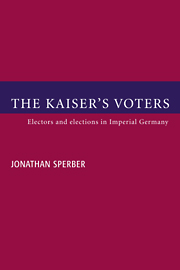6 - A century of democratic elections
Published online by Cambridge University Press: 22 October 2009
Summary
This final chapter, both conclusion and epilogue, is divided into four parts. The first is a summary and reformulation of the results of the analysis of elections in Imperial Germany. Then, in each of the three subsequent sections, these results will become the basis for a comparison. I will begin by considering the extent to which the results confirm or refute some of the common explanations of the reasons for voting in Imperial Germany, and offer my own suggestions as to how we might understand the electoral system of the Kaiserreich. The second comparison will be between the general elections held under the empire and those of the Weimar and Federal Republics. This will make it possible to develop some notion of long-term voting trends in Germany under a democratic franchise. Finally, I compare these trends in Germany with developments in other countries of Europe and in North America.
Elections, parties, and voters in the Kaiserreich
Elections
I will sum up the results of the work under the three rubrics given in the heading above. Starting with elections, it seems to me that two main results emerge from the analysis. The first is the contrast between the Bismarckian and Wilhelmine eras, or, more precisely, between the general elections of 1871–87 and those of 1890–1912. Table 6.1 illustrates one important feature of that contrast by dividing the electorate into one of five groups, defined by behavior in two subsequent elections: (1) party loyalists, those who voted for the same party grouping; (2) switchers, who went from one party grouping to another; (3) the mobilized and demobilized, who moved between not voting and voting, in either direction; (4) the non-voters, eligible voters…
- Type
- Chapter
- Information
- The Kaiser's VotersElectors and Elections in Imperial Germany, pp. 265 - 330Publisher: Cambridge University PressPrint publication year: 1997



